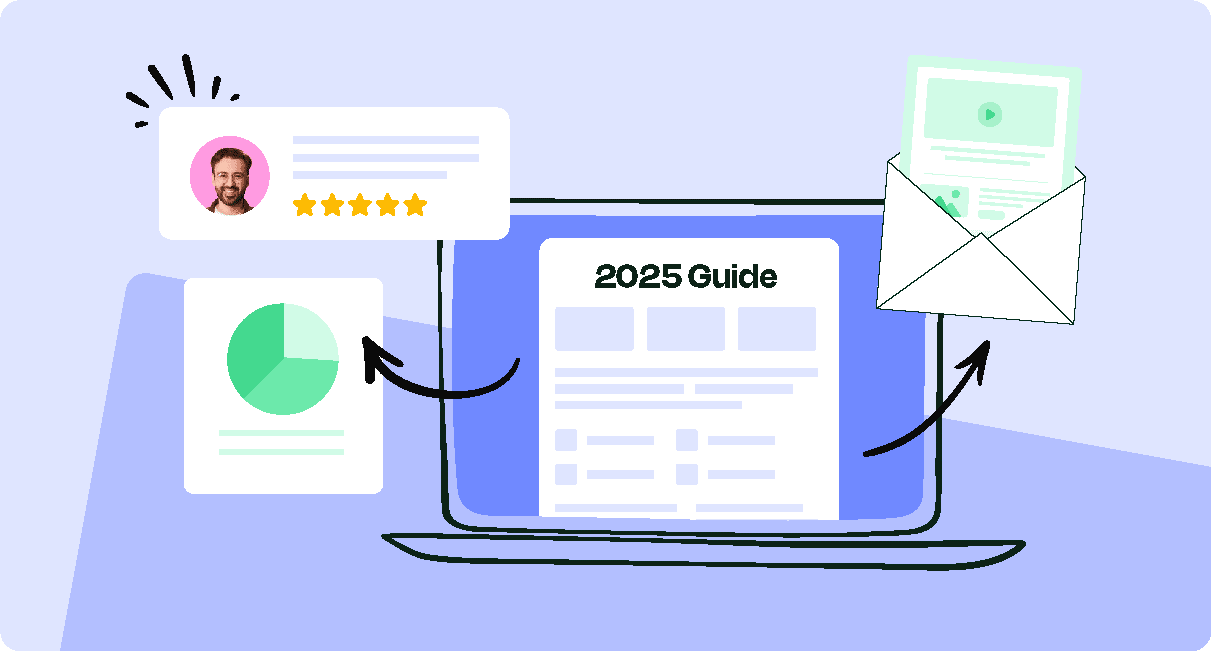Your employees are listening. Are you speaking their language or just adding to the noise? In this guide, we explain exactly how to craft an employee communication strategy that engages teams and drives action across your workforce.
Strong employee communication is the backbone of a high-performing workforce. In 2025, with hybrid work models, evolving employee expectations, and rapid tech advancements, it’s not enough to send a company-wide email and hope it lands.
HR and internal communications leaders need to architect thoughtful, responsive, and data-informed employee communication strategies that align with business goals and speak to the modern employee experience.
This comprehensive guide walks through everything you need to build a future-proof employee communication framework—from understanding its purpose to deploying cutting-edge tools.
Take a self-guided tour of ContactMonkey
See how our key features can streamline your internal communications.
Take product tour

What Is Employee Communication?
Employee communication refers to the exchange of information between an organization and its employees. This includes one-way updates, two-way feedback, leadership messaging, peer-to-peer dialogue, and everything in between.
While often used interchangeably with internal communication, the two aren’t the same. Internal communication is the umbrella term for all messaging within an organization, including IT updates, HR policies, and executive news. Employee communication, however, zeroes in on how you communicate with employees to engage, inform, and inspire.
Why Is Employee Communication More Important Than Ever?
We’re living through one of the most rapid periods of workplace transformation. From hybrid work and digital transformation to economic uncertainty and shifting employee expectations, change is constant—and often overwhelming. In times like these, effective employee communication is critical.
When done well, employee communication helps organizations stay aligned, agile, and resilient.
Here’s why it matters now more than ever:
- Supports change management: Whether you’re rolling out new systems, reorgs, or policy updates, clear communication helps employees understand the “why,” reducing confusion and resistance.
- Builds trust in uncertain times: Transparent, frequent updates signal that leadership is listening, aware, and invested in employee wellbeing.
- Drives employee engagement and retention: People want to feel connected, heard, and valued. A thoughtful employee communication strategy boosts morale and reduces turnover.
- Enables faster, better decision-making: When employees are informed, they’re empowered to act quickly and confidently.
- Strengthens organizational culture: Amid disruption, consistent messaging reinforces values, purpose, and belonging.
- Prevents misinformation and silos: A strong communication system keeps everyone on the same page—especially in hybrid and distributed environments.
In short, the benefits of employee communication are magnified when the ground is shifting. Change management communication isn’t just about sharing updates—it’s about keeping your people connected to your mission, each other, and what’s coming next.
What Is the Purpose of Employee Communication?
An effective employee communication strategy:
- Informs: Share accurate, timely information about company updates, policies, and initiatives.
- Engages: Build relationships and foster a sense of belonging.
- Aligns: Connect employees with the mission, vision, and strategy.
- Enables: Provide tools, knowledge, and context to help people do their jobs well.
- Empowers: Give employees a voice through surveys, feedback loops, and Q&A sessions.
Clear goals make it easier to improve employee communication and measure success.
Modern internal comms and measurement tools
No design or technical expertise needed. Save time, increase engagement, and dazzle your employees with fun and interactive communications.
Explore all features

Types of Employee Communication
Understanding the different modes of employee-to-employee communication and top-down messaging helps refine your strategy:
- One-way communication: Leadership updates, newsletters, and announcements.
- Two-way communication: Surveys, feedback channels, interactive town halls.
- Peer communication: Collaboration tools, group chats, informal exchanges.
- Crisis communication: Emergency updates, response protocols.
- Compliance communication: Required policies, legal updates, and mandatory training.
The strongest strategies blend multiple types for a dynamic and inclusive approach.
Examples of Employee Communications
Here are some common employee communication examples used by top organizations:
- Weekly company newsletters and emails
- Leadership video messages
- Interactive pulse surveys
- Employee appreciation messages
- Slack or Teams chat highlights
- Visual dashboards for company KPIs
- Internal podcasts
Employee Communication Channels
Choosing the right employee communication platforms can make or break your strategy. Here are the most effective channels:
- Email: Best for formal and consistent updates.
- Intranet: A centralized hub for information and resources.
- Chat tools (e.g., Slack, Teams): Ideal for informal, day-to-day interactions.
- SMS/text messaging: Excellent for time-sensitive, mobile-first communication.
- Digital signage: Useful for onsite teams and frontline workers.
- Town halls and video conferencing: Great for real-time engagement.
Use multiple formats, meet employees where they are, and take advantage of a comprehensive review of internal communication channels.
Watch ContactMonkey LIVE in action
Join live demo

Best Practices for Effective Employee Communication
Creating effective employee communication isn’t just about frequency—it’s about strategy and execution. Here are the top employee communication best practices:
- Clarity always wins: Avoid jargon. Be concise and direct.
- Consistency matters: Set a cadence and stick to it.
- Segment and personalize: Use data to tailor messaging to roles, locations, or seniority.
- Encourage two-way communication: Feedback is not optional; it’s essential.
- Design for mobile: Ensure accessibility across devices.
- Leverage multimedia: Mix text with video, images, and interactive elements.
- Measure everything: Track what works and optimize.
Also, don’t forget the 7 C’s of communication. For more formal messages, follow the extended framework: clear, concise, concrete, correct, coherent, complete, and courteous. These principles help structure professional communication and improve comprehension across teams.
To learn more, visit our article on internal communication best practices.
How to Create an Effective Employee Communication Strategy
A strong employee communication strategy doesn’t happen by accident—it’s built with intention, informed by data, and tailored to your workforce.
Here’s how to build an effective employee communication strategy, step-by-step:
1. Audit your current employee communication strategies
Before you build forward, you need to understand where you stand. A thorough internal communication audit reveals gaps, redundancies, and opportunities to improve employee communication across your organization.
Questions to answer:
- What channels are currently in use, and how effective are they?
- Are employees receiving too much or too little employee communication?
- Which messages consistently perform well (or poorly)?
- Do different departments or roles have different employee communication needs?
Steps to execute:
- Collect past communications (emails, announcements, videos, etc.).
- Review performance metrics: open rates, read time, click-through rates, and survey responses.
- Conduct an employee communication survey or interviews to uncover employee pain points and preferences.
- Map out channel usage: what’s being used, ignored, or underleveraged?
Considerations:
- Look for inconsistencies in branding, tone, or delivery.
- Compare employee-to-employee communication norms across departments.
- Don’t overlook informal channels (e.g., Teams, Slack)—these often reveal hidden issues or gaps in your employee communication strategy.


2. Define your employee communication goals and objectives
Clear goals are the foundation of any effective employee communication strategy. Internal communication goals provide direction, clarify purpose, and ensure alignment with business outcomes.
Questions to answer:
- What are we trying to achieve with employee communication?
- How does this support organizational priorities like engagement, retention, or productivity?
- How will success be measured?
Steps to execute:
- Align with leadership on strategic business objectives.
- Identify specific communication needs based on team feedback and audits.
- Translate goals into measurable KPIs and timelines.
Considerations:
- Use the benefits of employee communication to justify investments or program changes.
- Ensure your objectives balance top-down messaging with bottom-up feedback.
- Don’t forget cultural goals—employee communication can drive inclusion, trust, and belonging.
3. Understand your employee audience
Personalized communication resonates more deeply. Understanding your workforce enables you to design relevant and inclusive employee communication strategies.
Questions to answer:
- Who are your core audience segments (by role, region, work style)?
- What are their preferences, habits, and pain points?
- Do some employees feel disconnected or overwhelmed?
Steps to execute:
- Segment employees based on demographics, job function, or location.
- Conduct regular employee communication surveys to gather sentiment and preferences.
- Build employee personas to inform message design and delivery.
Considerations:
- Address different needs across frontline, hybrid, and remote employees.
- Pay attention to accessibility, especially in employee communication apps or intranet platforms.
- One-size-fits-all messaging can erode trust—targeting matters.
4. Choose the right channels for your employee communication strategy
Your channel mix should reflect how your employees work and how they want to receive information. Smart channel selection improves reach and effectiveness.
Questions to answer:
- Which employee communication platforms are already in use, and are they effective?
- Are there gaps for deskless, hybrid, or international teams?
- How mobile-friendly is our current communication setup?
Steps to execute:
- Map out which types of messages should go to which channels.
- Audit adoption and satisfaction with current employee communication tools.
- Introduce new formats like SMS for employee communication where relevant.
Considerations:
- Use real-time channels for urgent updates and asynchronous channels for deep reads.
- Integrated employee communication technology helps centralize analytics and streamline delivery.
- Test and iterate—what works for one team may not work for all.
BONUS: Leverage this how-to guide on creating an internal communication channel matrix for more insight on how to blend all your different channels together.
5. Build an effective employee communication messaging framework
Consistency in tone and message builds familiarity and credibility. A messaging framework ensures every piece of employee communication feels aligned and purposeful.
Questions to answer:
- What themes should be emphasized consistently?
- How should tone shift for leadership vs peer updates?
- What makes a good example of employer and employee communication?
Steps to execute:
- Define message pillars (e.g., transparency, recognition, inclusion).
- Develop tone-of-voice and style guidelines.
- Create standardized templates using your employee communication software.
Considerations:
- Give leaders and people managers communication playbooks or toolkits.
- Reinforce values and culture through repeated themes and stories.
- Use visual identity consistently across channels for stronger brand recognition.
6. Build and manage a content calendar
A proactive approach ensures timely and consistent communication. A calendar keeps messaging aligned, avoids duplication, and reinforces cadence.
Questions to answer:
- What recurring themes and moments do we need to communicate around?
- How often should each audience segment be hearing from us?
- Who owns what content, and how is it maintained?
Steps to execute:
- Plan out weekly, monthly, and quarterly communications.
- Include a mix of formats: newsletters, surveys, updates, celebrations.
- Use automation or scheduling tools within your employee communication platform to streamline.
Considerations:
- Be flexible—leave room for urgent or real-time messages.
- Mix top-down with peer-driven or crowdsourced content.
- Share the calendar with cross-functional teams for visibility.
BONUS: For a step-by-step on content calendar development, we put together a piece on how to create an internal communications content calendar. Less executional thinking for you, more time spent on strategy!
Plan like a pro: 2025 Internal Communications Calendar
Map out key dates and plan for your success.
Get the guide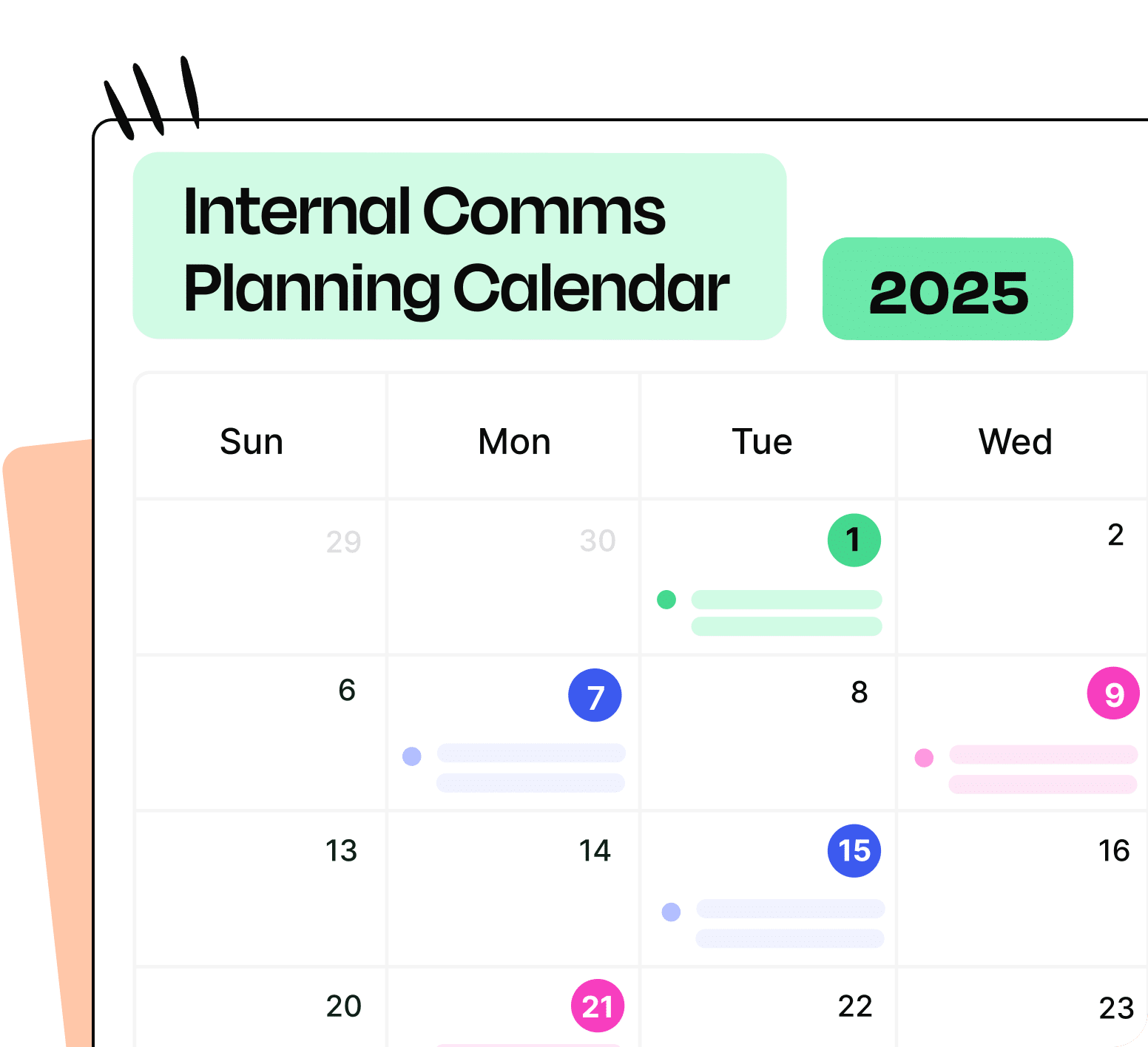
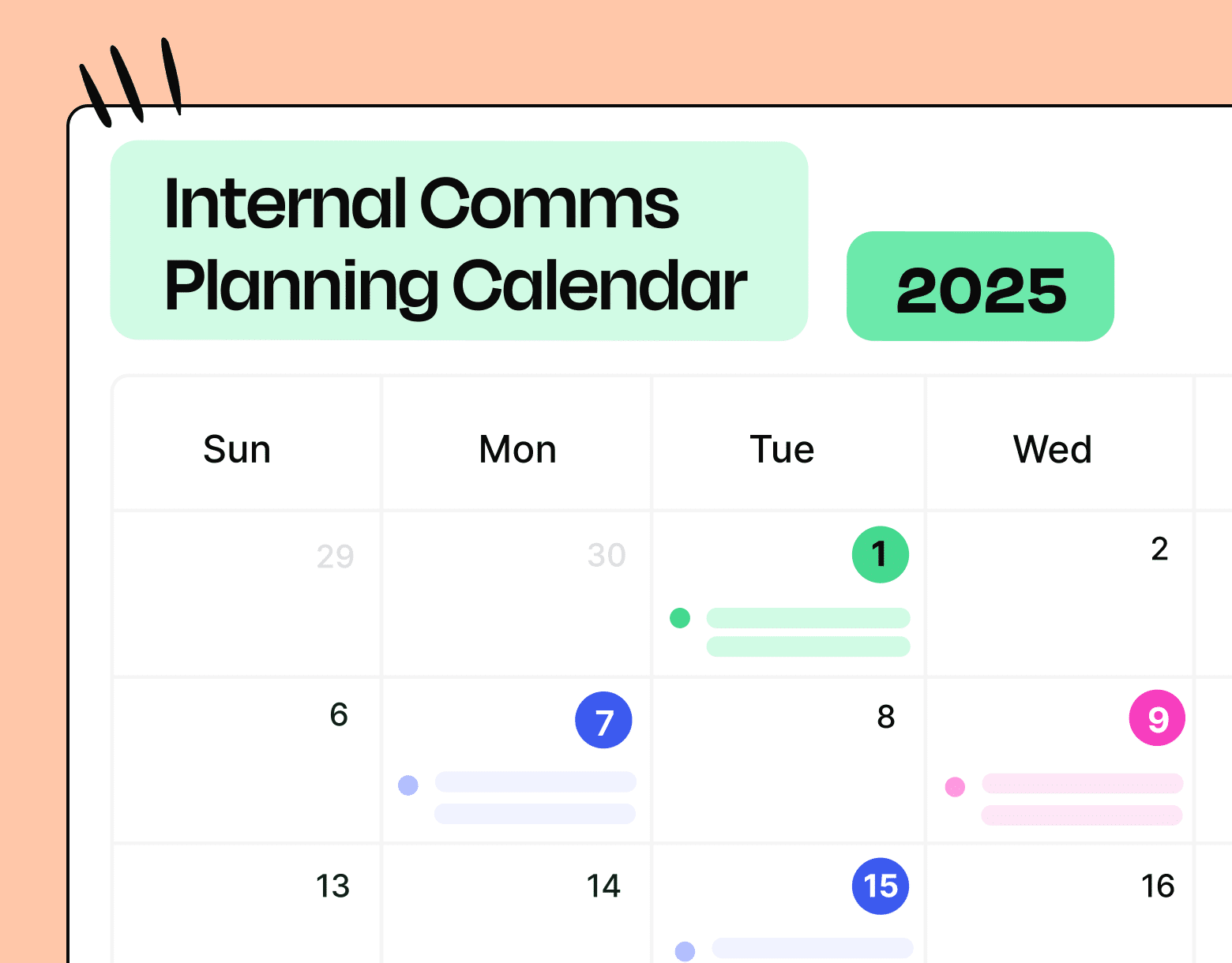
7. Implement feedback loops in your employee communication strategy
Employee feedback loops aren’t optional—it’s the foundation of two-way employee communication. Without it, your strategy lacks credibility and adaptability.
Questions to answer:
- How do employees currently give feedback—and do they feel heard?
- What channels are best suited for gathering input?
- Are we closing the loop after receiving feedback?
Steps to execute:
- Launch short, frequent pulse surveys and feedback forms.
- Create anonymous options for sensitive feedback.
- Regularly communicate outcomes and actions taken based on feedback.
Considerations:
- Tie survey themes to key topics like wellbeing, engagement, or clarity of communication.
- Use employee communication survey questions that invite reflection, not just ratings.
- Celebrate wins that result from employee input—build a culture of listening.
8. Measure, optimize, and evolve your employee communications
Your employee communication strategy should never be static. Regular measurement helps you iterate, improve, and prove value to stakeholders.
Questions to answer:
- What are our key success metrics, and how often are we reviewing them?
- Which types of employee communication are driving the most engagement?
- Are there any blind spots in our data?
Steps to execute:
- Track metrics like email open rates, click-throughs, read time, and survey response rates.
- Analyze engagement by audience segment or channel.
- Use data visualization tools built into your employee communication software to share reports.
Considerations:
- Pair quantitative metrics with qualitative feedback for a full picture.
- Set quarterly benchmarks to track progress.
- Share results with leadership to reinforce the benefits of employee communication as a strategic function.
With a structured plan, employee communication training, and buy-in from leadership, this becomes a powerful tool for retention and performance.
BONUS: To help you adopt new ways of thinking, our article on internal communication strategy ideas and examples offers you 20 different approaches to establishing your long-term plan.
Get powerful email analytics and reporting features
Know exactly who is opening and engaging with your employee communications and company newsletters.
Explore analytics & reporting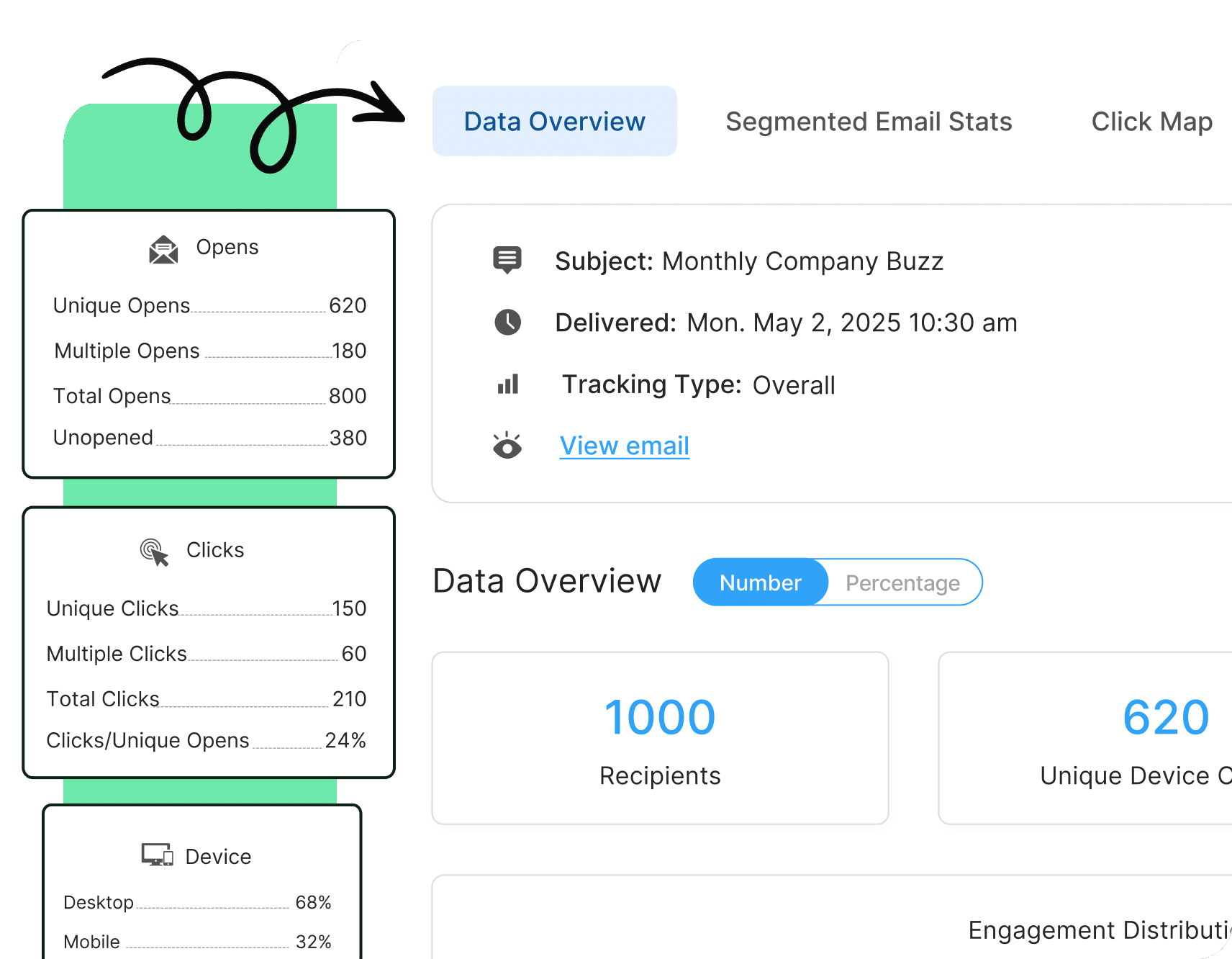
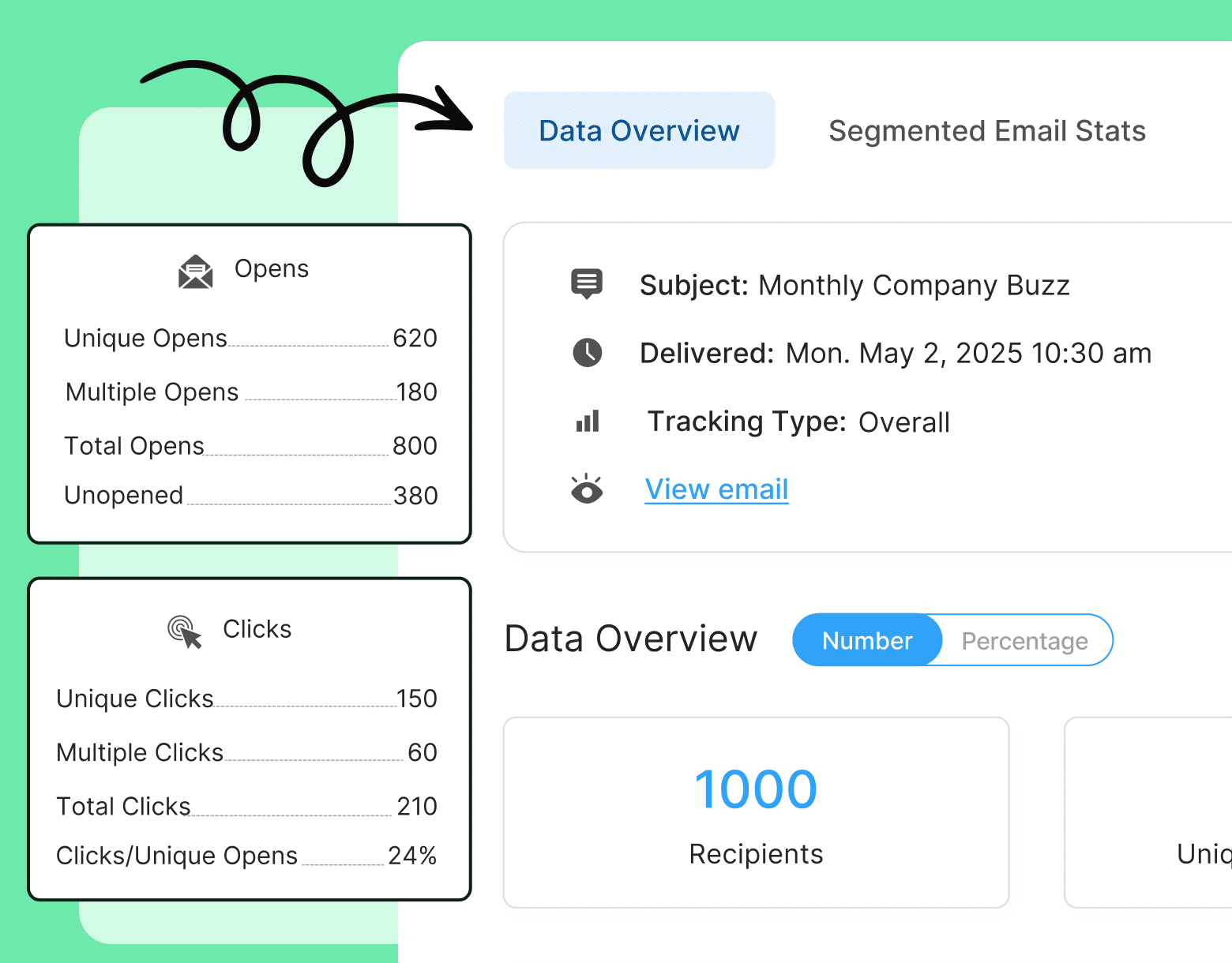
How to Improve Employee Communication
Whether starting from scratch or refining your approach, here’s how to improve employee communication:
- Set communication benchmarks: Use metrics like open rate, read time, and survey participation.
- Run regular internal comms audits: Identify gaps and areas of over- or under-communication.
- Ask better questions: Use smart employee communication survey questions to uncover real sentiment.
- Use storytelling: Celebrate people, projects, and impact through narrative.
- Involve leadership: The best communicators lead by example.
- Empower managers: Train middle managers to become strong communicators.
- Use data to guide: Let analytics shape your strategy.
Regular assessment and iteration are key to sustainable improvement. You can also check out this guide on employee engagement KPIs to help you determine what to measure for success.
Employee Communication Software and Technology
No matter how solid your strategy, it’s only as effective as the tools you use. Modern employee communication technology makes content creation, delivery, and measurement seamless.
Top tools include:
- ContactMonkey: An employee communication platform that integrates with Outlook and Gmail, making it easy to design, send, and track internal emails. Add surveys, videos, and personalized dynamic content.
- Slack: For real-time, conversational updates.
- SurveyMonkey: For collecting feedback.
- Simpplr: Feature-rich intranet solutions.
Review a full list here of internal communication tools and employee communication apps that support your goals and scale with your team.
How ContactMonkey Can Help You Create and Execute Your Employee Communication Strategy
The landscape of employee communication is shifting fast, but that also means there is a massive opportunity. When you adopt intentional, tech-enabled, and employee-first communication approaches, you move them.
Here’s how ContactMonkey helps at every stage of your strategy:
- Drag-and-Drop Email Builder Feature: Design visually engaging, on-brand emails without needing IT support.
- Dynamic Content Feature: Personalize emails by department, location, or role—all within one email.
- Employee Feedback Features: Gather real-time employee insights directly from your emails.
- Analytics Dashboard Feature: Track open rates, click-throughs, read time, and location-based engagement.
- Responsive email design: Ensure your employee communications look great on every device, including mobile.
Whether you’re looking to improve employee communication, boost engagement, or drive business outcomes, now is the time to reassess your strategy. Our experts are available to help guide you through – book a 15-minute call today to get started!


